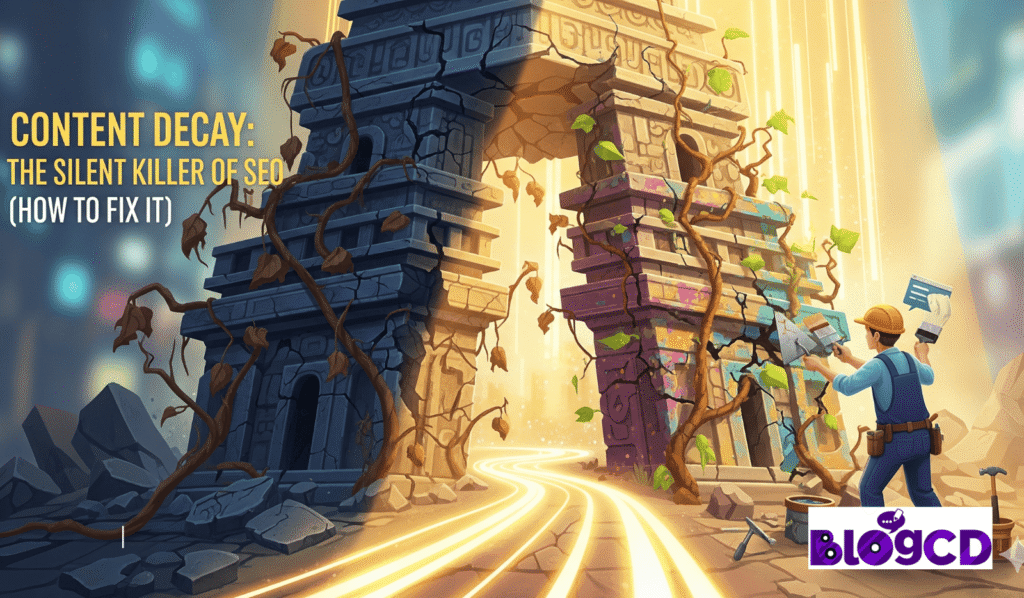If your website once ranked at the top of Google but now feels like it’s quietly slipping down the search results, you’re not alone. Many site owners and SEO professionals face this problem without realizing what’s happening until it’s too late.
The culprit? Content decay — a slow, creeping decline in rankings, traffic, and engagement that happens when your content loses relevance over time.
The scary part is that it doesn’t happen overnight. It takes months, sometimes even a year, for the impact to show, which is why so many SEOs overlook it.
In this guide, I’ll explain what content decay is, the warning signs you should never ignore, and a proven system to fight back.
What Is Content Decay?
Content decay is the gradual decline of a webpage’s performance in organic search due to changing algorithms, user expectations, and competitor activity.
Unlike a penalty or technical issue that causes sudden drops, content decay is subtle and progressive. You may notice:
- Fewer impressions month over month.
- Declining click-through rates (CTR).
- Competitors overtaking you on keywords you’ve dominated for years.
In short, it’s the slow death of once-valuable content.
Why Does Content Decay Happen?
Several factors contribute to content decay, and they all tie back to how Google and users interact with information:
- Google’s AI favors freshness
Google wants to deliver the most relevant and recent content. Articles that remain unchanged for years will eventually lose their competitive edge. - Users expect current information
Whether it’s tech trends, SEO strategies, or product updates, people want up-to-date answers. Outdated posts quickly lose credibility. - Competitors update more often
If your competitors are refreshing their content quarterly while you leave yours untouched, they’ll eventually outrank you. - Search intent evolves
The way people search changes over time. A keyword that once indicated “how-to” intent might now lean toward “tools” or “services.” If your content no longer matches, you lose relevance.
Red Flags: How to Spot Content Decay Early
One reason content decay is so dangerous is because it sneaks up on you. Here are some signals to watch for:
- Gradual ranking decline over 6 to 12 months.
- Falling CTR on pages that previously performed well.
- Competitors leapfrogging you for long-held keywords.
- Lower engagement metrics, like time on page and conversions.
If you notice these trends, your content may already be decaying.
A Proven System to Fight Content Decay
The good news? Content decay isn’t permanent. With the right system, you can revive and even strengthen your rankings.
1. Audit Your Top Pages Quarterly
- Review your top 20 traffic-driving pages every 3 months.
- Check rankings, impressions, CTR, and engagement.
- Prioritize updates for content tied to revenue (money pages).
2. Set Ranking Alerts
- Use tools like Ahrefs, SEMrush, or Google Search Console to track performance.
- Set up notifications for sudden or steady ranking drops.
- Act early before the decline becomes severe.
3. Monitor Competitor Updates
- Watch how often competitors in your niche update their blogs or landing pages.
- Look at new sections, FAQs, or multimedia they add.
- Identify patterns and adjust your refresh schedule accordingly.
4. Create a Content Refresh Calendar
Not all content decays at the same speed. Build a schedule like this:
- Fast-moving industries (SEO, finance, tech): refresh every 3–6 months.
- Moderate industries (lifestyle, health, travel): refresh every 6–12 months.
- Evergreen topics (history, definitions): review annually but update when needed.
5. Optimize for Changing Intent
Reanalyze your target keywords. Ask:
- Has the search intent shifted?
- Do users now prefer video, guides, or product comparisons?
- Can I expand my content to answer new questions?
Refreshing with intent in mind ensures long-term relevance.
Practical Refresh Tips
When you refresh content, don’t just change the date. Add real value:
- Update outdated statistics and examples.
- Expand sections to match new subtopics.
- Improve formatting for readability (tables, lists, FAQs).
- Add visuals, charts, or videos for engagement.
- Strengthen internal linking to other relevant pages.
Remember: freshness is about quality improvements, not quick edits.
The New Reality: “Publish Once and Forget” Is Dead
The old SEO approach of publishing an article and leaving it untouched is no longer effective. Search is evolving too quickly.
If you want your content to keep ranking, ongoing maintenance is mandatory. Think of it like gardening: you can’t plant once and expect the garden to thrive forever. It requires care, pruning, and attention.
Conclusion
Content decay is a silent SEO killer that can drain your traffic before you realize it’s happening. But by identifying the warning signs and implementing a refresh system, you can not only protect your rankings but also gain an edge over competitors who fail to adapt.
✅ Audit your content quarterly
✅ Track ranking changes on key pages
✅ Monitor competitor refresh cycles
✅ Build a refresh schedule that fits your industry
Consistency is the cure. Refresh, refine, and re-optimize — and your content will continue to grow instead of decay.

